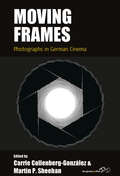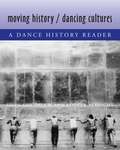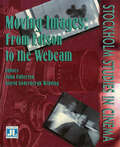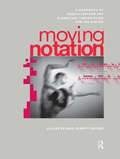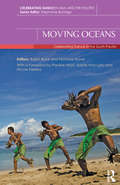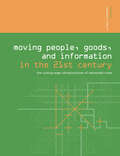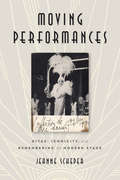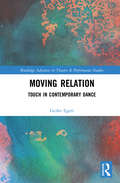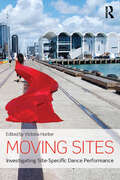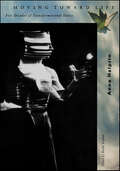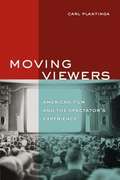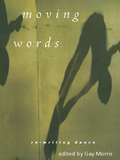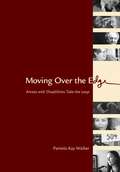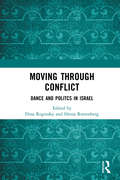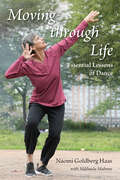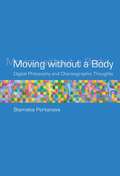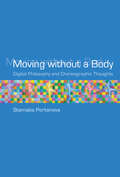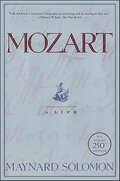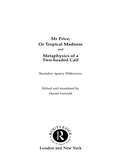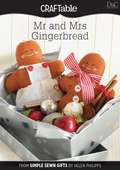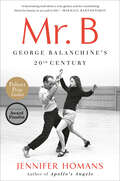- Table View
- List View
Moving Frames: Photographs in German Cinema (Film Europa #26)
by Carrie Collenberg-González Martin P. SheehanAs the building blocks of moving pictures, photographs have played an integral role in cinema since the dawn of the medium—a relationship that has grown more complexly connected even as the underlying technologies continue to evolve. Moving Frames explores the use of photographs in German films from Expressionism to the Berlin School, addressing the formal and narrative roles that photographs play as well as the cultural and historical contexts out of which these films emerged. Looking beyond and within the canon, the editors gather stimulating new insights into the politics of surveillance, resistance, representation, and collective memory functioning through photographic rupture and affect in German cinema.
Moving History/Dancing Cultures
by Ann Cooper Albright Ann DilsThis new collection of essays surveys the history of dance in an innovative and wide-ranging fashion. Editors Dils and Albright address the current dearth of comprehensive teaching material in the dance history field through the creation of a multifaceted, non-linear, yet well-structured and comprehensive survey of select moments in the development of both American and World dance. This book is illustrated with over 50 photographs, and would make an ideal text for undergraduate classes in dance ethnography, criticism or appreciation, as well as dance history--particularly those with a cross-cultural, contemporary, or an American focus. The reader is organized into four thematic sections which allow for varied and individualized course use: Thinking about Dance History: Theories and Practices, World Dance Traditions, America Dancing, and Contemporary Dance: Global Contexts. The editors have structured the readings with the understanding that contemporary theory has thoroughly questioned the discursive construction of history and the resultant canonization of certain dances, texts and points of view. The historical readings are presented in a way that encourages thoughtful analysis and allows the opportunity for critical engagement with the text. Ebook Edition Note: Ebook edition note: Five essays have been redacted, including "The Belly Dance: Ancient Ritual to Cabaret Performance," by Shawna Helland; "Epitome of Korean Folk Dance", by Lee Kyong-Hee; "Juba and American Minstrelsy," by Marian Hannah Winter; "The Natural Body," by Ann Daly; and "Butoh: 'Twenty Years Ago We Were Crazy, Dirty, and Mad',"by Bonnie Sue Stein. Eleven of the 41 illustrations in the book have also been redacted.
Moving Images: From Edison to the Webcam (Stockholm Studies in Cinema)
by John Fullerton, Astrid Söderbergh WiddingSeventeen essays examining the impact of new media on the history of cinema.In 1888, Thomas Edison announced that he was experimenting on “an instrument which does for the eye what the phonograph does for the ear, which is the recording and reproduction of things in motion.” Just as Edison’s investigations were framed in terms of the known technologies of the phonograph and the microscope, the essays in this collection address the contexts of innovation and reception that have framed the development of moving images in the last one hundred years. Three concerns are of particular interest: the contexts of innovation and reception for moving image technologies; the role of the observer, whose vision and cognitive processes define some of the limits of inquiry and epistemological insight; and the role of new media, which, engaging with the domestic sphere as cultural interface, are transforming our understanding of public and private spheres.The seventeen previously unpublished essays in Moving Images represent the best of current research in the history of this field. They make a timely and stimulating contribution to debates concerning the impact of new media on the history of cinema.Contributors include: William Boddy, Carlos Bustamante, Warren Buckland, Valeria Camporesi, Bent Fausing, Oliver Gaycken, Alison Griffiths, Christopher Hales, Jan Holmberg, Solveig Jülich, Frank Kessler, Jay Moman, Sheila C. Murphy, Pelle Snickars, Paul C. Spehr, Björn Thuresson, and Åke Walldius.
Moving Notation (Performing Arts Studies #Vol. 6)
by Jill Beck Joseph ReiserDesigned specifically for university-level study, Moving Notation will benefit students and teachers of both dance and music, offering a complete introduction to the theory and practice of musical rhythm and elementary Labanotation. Performing Arts Studies aims to provide stimulating resource books of both a practical and philosophical nature for teachers and students of the performing arts: music, dance, theatre, film, radio, video, oral poetry, performance art, and multi-media forms.
Moving Oceans: Celebrating Dance in the South Pacific (Celebrating Dance in Asia and the Pacific)
by Nicholas Rowe Ralph BuckCelebrating the diversity of dance across the South Pacific, this volume studies the various experiences, motivations and aims for dance, emerging from the voices of dance professionals in the islands. In particular, it focuses on the interplay of cultures and pathways of migration as people move across the region discovering new routes and connections.
Moving People, Goods and Information in the 21st Century: The Cutting-Edge Infrastructures of Networked Cities (Networked Cities Series)
by Richard E HanleyGlobalisation and technological innovation have changed the way people, goods, and information move through and about cities. To remain, or become, economically and environmentally sustainable, cities and their regions must adapt to these changes by creating cutting-edge infrastructures that integrate advanced technologies, communications, and multiple modes of transportation. The book defines cutting-edge infrastructures, details their importance to cities and their regions, and addresses the obstacles to creating those infrastructures.
Moving Performances: Divas, Iconicity, and Remembering the Modern Stage
by Jeanne ScheperFabulous yet fierce, imperious yet impetuous, boss yet bitchy—divas are figures of paradox. Their place in culture is equally contradictory, as they are simultaneously venerated and marginalized, hailed as timeless but then frequently forgotten or exhumed as cult icons by future generations. Focusing on four early twentieth-century divas—Aida Overton Walker, Loïe Fuller, Libby Holman, and Josephine Baker—who were icons in their own time, Moving Performances considers what their past and current reception reveals about changing ideas of race and gender. Jeanne Scheper examines how iconicity can actually work to the diva’s detriment, reducing her to a fetish object, a grotesque, or a figure of nostalgia. Yet she also locates more productive modes of reception that reach to revive the diva’s moving performances, imbuing her with an affective afterlife. As it offers innovative theorizations of performance, reception, and affect, Moving Performances also introduces readers to four remarkable women who worked as both cultural producers and critics, deftly subverting the tropes of exoticism, orientalism, and primitivism commonly used to dismiss women of color. Rejecting iconic depictions of these divas as frozen in a past moment, Scheper vividly demonstrates how their performances continue to inspire ongoing movements.
Moving Relation: Touch in Contemporary Dance (Routledge Advances in Theatre & Performance Studies)
by Gerko EgertMoving Relation explores the notion of touch in the realm of contemporary dance. By closely analyzing performances by well-known European and American choreographers such as Meg Stuart, William Forsythe, Xavier Le Roy, Jared Gradinger and Angela Schubot, this book investigates their usage of touch on the level of movement, experience and affect. Building on the proposition that touch is more than the moment of bodily contact, the author demonstrates the concept of touch as an interplay of movements and multiple relations of proximity. Egert employs both depth, using close descriptions and analyses of dance performances with theoretical investigations of touch, with breadth, working across the fields of performance and dance studies, philosophy and cultural theory. Suitable for scholars and practitioners in the fields of dance and performance studies, Moving Relation uses a process-oriented notion of touch to reevaluate key concepts such as the body, rhythm, emotional expression, subjectivity and audience perception.
Moving Shakespeare Indoors
by Andrew Gurr Farah Karim-CooperShakespeare's Company, the King's Men, played at the Globe, and also in an indoor theatre, the Blackfriars. The year 2014 witnesses the opening of the Sam Wanamaker Playhouse, based on seventeenth-century designs of an indoor London theatre and built within the precincts of the current Globe on Bankside. This volume, edited by Andrew Gurr and Farah Karim-Cooper, asks what prompted the move to indoor theatres, and considers the effects that more intimate staging, lighting and music had on performance and repertory. It discusses what knowledge is required when attempting to build an archetype of such a theatre, and looks at the effects of the theatre on audience behaviour and reception. Exploring the ways in which indoor theatre shaped the writing of Shakespeare and his contemporaries in the late Jacobean and early Caroline periods, this book will find a substantial readership among scholars of Shakespeare and Jacobean theatre history.
Moving Sites: Investigating Site-Specific Dance Performance
by Victoria HunterMoving Sites explores site-specific dance practice through a combination of analytical essays and practitioner accounts of their working processes. In offering this joint effort of theory and practice, it aims to provide dance academics, students and practitioners with a series of discussions that shed light both on approaches to making this type of dance practice, and evaluating and reflecting on it. The edited volume combines critical thinking from a range of perspectives including commentary and observation from the fields of dance studies, human geography and spatial theory in order to present interdisciplinary discourse and a range of critical and practice-led lenses through which this type of work can be considered and explored. In so doing, this book addresses the following questions: · How do choreographers make site-specific dance performance? · What occurs when a moving body engages with site, place and environment? · How might we interpret, analyse and evaluate this type of dance practice through a range of theoretical lenses? · How can this type of practice inform wider discussions of embodiment, site, space, place and environment? This innovative and exciting book seeks to move beyond description and discussion of site-specific dance as a spectacle or novelty and considers site-dance as a valid and vital form of contemporary dance practice that explores, reflects, disrupts, contests and develops understandings and practices of inhabiting and engaging with a range of sites and environments. Dr Victoria Hunter is Senior Lecturer in Dance at the University of Chichester.
Moving Toward Life: Five Decades of Transformational Dance
by Anna HalprinAnna Halprin is one of the most important innovators in the history of modern dance, performance art, and post-modern dance. Moving Toward Life brings together for the first time her essays, interviews, manifestos, and teaching materials, along with over 100 illustrations, providing a rich account of the work that radicalized an entire generation of performers.Since the late 1950s, Halprin has been at the forefront of experiments in dance, from improvisation and street theatre to dances in the environment and healing dances. A brief overview of Halprin's career shows how her work has prefigured — and transfigured — crucial developments in postmodern dance. In the 1960s, Halprin invented the "workshop," and in the wake of the Watts riots, her multiracial company broke boundaries in their confrontational political performances. In the 1970s, she organized "community rituals" to explore how individual creativity feeds positively into group dynamics. These healing social events led to her current work with cancer survivors and people challenging AIDS and their caregivers.Depicting Halprin's deep commitment to social change, Moving Toward Life presents an engaging, critical document of the life of one of the most influential and least known luminaries of American dance. Sally Banes and Janice Ross join Rachel Kaplan in providing introductory essays to sections of the book.
Moving Viewers: American Film and the Spectator's Experience
by Carl PlantingaCarl Plantinga explores the question of why movie watching becomes a compelling emotional experience and the implications of its answer for aesthetics, the psychology of spectatorship, and the place of movies in culture.
Moving Words: Re-Writing Dance
by Gay MorrisMoving Words provides a direct line into the most pressing issues in contemporary dance scholarship, as well as insights into ways in which dance contributes to and creates culture. Instead of representing a single viewpoint, the essays in this volume reflect a range of perspectives and represent the debates swirling within dance. The contributors confront basic questions of definition and interpretation within dance studies, while at the same time examining broader issues, such as the body, gender, class, race, nationalism and cross-cultural exchange. Specific essays address such topics as the black male body in dance, gender and subversions in the dances of Mark Morris, race and nationalism in Martha Graham's 'American Document', and the history of oriental dance.
Moving over the Edge: Artists with Disabilities Take the Leap
by Pamela K. WalkerA book about the author's coming of age alongside disability activists and artists with disabilities, reflecting the sociological evolution from disability rights to disability culture. It features many of the artists and groups that emerged in the San Francisco Bay Area in the late 1980s, including Axis Dance Company, Bruce Curtis, CJ Jones, David Roche, Cheryl Marie Wade and Wry Crips Disabled Women's Theater.
Moving through Conflict: Dance and Politcs in Israel
by Dina Roginsky Henia RottenbergMoving through Conflict: Dance and Politics in Israel is a pioneering project in examining the Israeli–Palestinian conflict through dance. It proposes a research framework for study of the social, cultural, aesthetic and political dynamics between Jews and Arabs as reflected in dance from late 19th-century Palestine to present-day Israel. Drawing on multiple disciplines, this book examines a variety of social and theatrical venues (communities, dance groups, evening classes and staged performances), dance genres (folk dancing, social dancing and theatrical dancing) and different cultural identities (Israeli, Palestinian and American). Underlying this work is a fundamental question: can the body and dance operate as nonverbal autonomous agents to mediate change in conflicting settings, transforming the "foreign" into the "familiar"? Or are they bound to their culturally dependent significance – and thus nothing more than additional sites of an embodied politics? This anthology expounds on various studies on dance, historical periods, points of view and points of contact that help promote thinking about this fundamental issue. It will be of great interest to students and scholars of dance studies, sociology, anthropology, art history, education and cultural studies, as well as conflict and resolution studies.
Moving through Life: Essential Lessons of Dance
by Naomi Goldberg HaasA story of resilience, joyful creativity, and the empowering potential of dance Moving through Life traces the journey of influential dancer, teacher, and choreographer Naomi Goldberg Haas. Sharing her lifelong love of movement, her experiences as a dancer with chronic health conditions, and accessible exercises from her work with dancers of all ages and abilities, Goldberg Haas encourages readers to integrate dance into their lives and to move with awareness, creativity, and joy. Goldberg Haas describes her early years as an emerging dancer at the School of American Ballet and how she explored and reveled in many dance forms throughout her career. She takes readers from a focus on fundamentals such as balance, strength, and flexibility to a deeper understanding of dance as a transformational community practice. With a unique perspective informed by navigating a degenerative neuromuscular disease, Goldberg Haas conveys a positive message: dance is an opportunity for renewal and growth at all stages of life. Alongside Goldberg Haas’s story, this book provides insights and step-by-step instructions from the Movement Speaks® curriculum developed by Goldberg Haas for her nonprofit Dances for a Variable Population, a program that brings dance to older adults in New York City. Readers will learn from Goldberg Haas to exercise both their bodies and minds in ways that work for them. They will discover for themselves what Goldberg Haas’s life illustrates—the value of dance in improving physical, mental, and social wellbeing. In a memoir of personal struggle, resilience, and celebration, Goldberg Haas portrays many of the changes that can come with aging and embraces the empowering potential of dance. From childhood memories to moments of epiphany later in life, this account from a leading figure in the dance community shows how movement can enrich and improve the lives of everyone.
Moving without a Body
by Stamatia PortanovaDigital technologies offer the possibility of capturing, storing, and manipulating movement, abstracting it from the body and transforming it into numerical information. In Moving without a Body, Stamatia Portanova considers what really happens when the physicality of movement is translated into a numerical code by a technological system. Drawing on the radical empiricism of Gilles Deleuze and Alfred North Whitehead, she argues that this does not amount to a technical assessment of software's capacity to record motion but requires a philosophical rethinking of what movement itself is, or can become. Discussing the development of different audiovisual tools and the shift from analog to digital, she focuses on some choreographic realizations of this evolution, including works by Loie Fuller and Merce Cunningham. Throughout, Portanova considers these technologies and dances as ways to think -- rather than just perform or perceive -- movement. She distinguishes the choreographic thought from the performance: a body performs a movement, and a mind thinks or choreographs a dance. Similarly, she sees the move from analog to digital as a shift in conception rather than simply in technical realization. Analyzing choreographic technologies for their capacity to redesign the way movement is thought, Moving without a Body offers an ambitiously conceived reflection on the ontological implications of the encounter between movement and technological systems.
Moving without a Body: Digital Philosophy and Choreographic Thoughts (Technologies of Lived Abstraction)
by Stamatia PortanovaA radically empirical exploration of movement and technology and the transformations of choreography in a digital realm.Digital technologies offer the possibility of capturing, storing, and manipulating movement, abstracting it from the body and transforming it into numerical information. In Moving without a Body, Stamatia Portanova considers what really happens when the physicality of movement is translated into a numerical code by a technological system. Drawing on the radical empiricism of Gilles Deleuze and Alfred North Whitehead, she argues that this does not amount to a technical assessment of software's capacity to record motion but requires a philosophical rethinking of what movement itself is, or can become.Discussing the development of different audiovisual tools and the shift from analog to digital, she focuses on some choreographic realizations of this evolution, including works by Loie Fuller and Merce Cunningham. Throughout, Portanova considers these technologies and dances as ways to think—rather than just perform or perceive—movement. She distinguishes the choreographic thought from the performance: a body performs a movement, and a mind thinks or choreographs a dance. Similarly, she sees the move from analog to digital as a shift in conception rather than simply in technical realization. Analyzing choreographic technologies for their capacity to redesign the way movement is thought, Moving without a Body offers an ambitiously conceived reflection on the ontological implications of the encounter between movement and technological systems.
Mozart: A Life
by Maynard SolomonOn the occasion of Mozart's two hundred and fiftieth birthday, read Maynard Solomon's Mozart: A Life, universally hailed as the Mozart biography of our time.
Mr Price, or Tropical Madness and Metaphysics of a Two- Headed Calf
by Stanislaw Ignacy WitkiewiczThe Polish playwright and artist Stanislaw Ignacy Witkiewicz, known as Witkacy, is now recognized as Poland's leading theatrical innovator of the interwar years and one of the outstanding creative personalities of the European avant-garde. This volume contains two of Witkacy's "tropical" plays inspired by the playwright's trip to Ceylon and Australia in 1914 with his close friend, the anthropologist Bronislaw Malinowski. Mr. Price, or Tropical Madness is a drama of heightened passion and greed among British colonists in Rangoon who seem to have stepped out of Joseph Conrad's tales of the South Seas. Metaphysics of a Two headed Calf, set in New Guinea and Australia, pits savage European imperialists against a native tribal Australia and pits savage European imperialists against a native tribal chieftain whose fetish of a great golden frog offers greater insight into the mystery of existence than the Westerners' shallow rationalism. Both plays puncture the white rulers' poses of superiority and parody their images of the tropical Other. Also included in the volume are Witkacy's Foreword to Metaphysics of a Two-Headed Calf in which the playwright defends his concept of theatre as an autonomous art with a scenic language of its own and an appendix containing a documentary itinerary of Witkacy's journey to Ceylon.
Mr Spock's Little Book of Mindfulness: How to Survive in an Illogical World
by Glenn DakinWho better to teach us mindfulness and wisdom than Mr. Spock, that beacon of calm, rational thought. With quotes from STAR TREK and timely insights about modern life this book will be your guide. In a universe that seems to have gone mad, we turn to mindfulness to restore sanity. When humanity has lost its way, it takes a Vulcan to raise an eyebrow at our folly and lead us towards the truth. After all, it's only logical ...The perfect holiday gift for the Star Trek fan in your life!Essays on focus, computers, social media, love, family, self-acceptance and more.Filled with actual quotes from Mr. Spock and Star Trek characters, along with black & white illustrations. Includes source listing from TV episodes.
Mr and Mrs Gingerbread
by Helen PhilippsThese cute cookie-shaped toys make lovely decorations for the kitchen at any time of year. You could make Mr and Mrs Gingerbread, as shown here, or make a whole family and decorate each one in a slightly different way by using a variety of ribbons and other embellishments. You could also make padded gingerbread hearts and stars from the same linen to match the gingerbread family.
Mr. B: George Balanchine's 20th Century
by Jennifer Homans&“A fascinating read about a true genius and his unrelenting thirst for beauty in art and in life.&”—MIKHAIL BARYSHNIKOVBased on a decade of unprecedented research, the first major biography of George Balanchine, a broad-canvas portrait set against the backdrop of the tumultuous century that shaped the man The New York Times called &“the Shakespeare of dancing&”—from the bestselling author of Apollo&’s AngelsArguably the greatest choreographer who ever lived, George Balanchine was one of the cultural titans of the twentieth century—The New York Times called him &“the Shakespeare of dancing.&” His radical approach to choreography—and life—reinvented the art of ballet and made him a legend. Written with enormous style and artistry, and based on more than one hundred interviews and research in archives across Russia, Europe, and the Americas, Mr. B carries us through Balanchine&’s tumultuous and high-pitched life story and into the making of his extraordinary dances.Balanchine&’s life intersected with some of the biggest historical events of his century. Born in Russia under the last czar, Balanchine experienced the upheavals of World War I, the Russian Revolution, exile, World War II, and the Cold War. A co-founder of the New York City Ballet, he pressed ballet in America to the forefront of modernism and made it a popular art. None of this was easy, and we see his loneliness and failures, his five marriages—all to dancers—and many loves. We follow his bouts of ill health and spiritual crises, and learn of his profound musical skills and sensibility and his immense determination to make some of the most glorious, strange, and beautiful dances ever to grace the modern stage.With full access to Balanchine&’s papers and many of his dancers, Jennifer Homans, the dance critic for The New Yorker and a former dancer herself, has spent more than a decade researching Balanchine&’s life and times to write a vast history of the twentieth century through the lens of one of its greatest artists: the definitive biography of the man his dancers called Mr. B.
Mr. Blue
by Priscilla WhitakerFeaturing stunning photography, Mr. Blue invites children into the vibrant world of a Great Blue Heron. The story of Mr. Blue delights, engages, and educates children about his playful personality and natural habitat. Fishing in a pond, balancing on one leg, and playing hide-and-seek are just some of the activities Mr. Blue can do while spending the day at his pond. Join him on the banks of his pond as you explore the watery world of this amazing bird.
